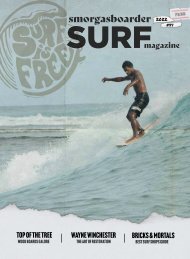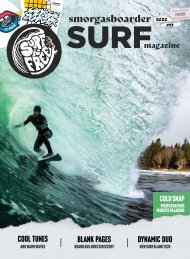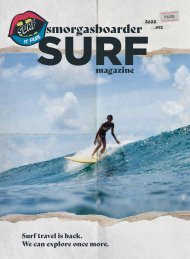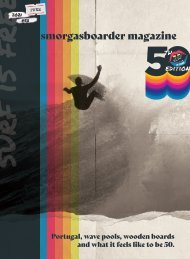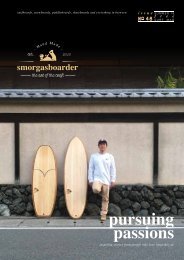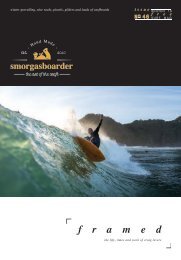Smorgasboarder_16_March-2013
You also want an ePaper? Increase the reach of your titles
YUMPU automatically turns print PDFs into web optimized ePapers that Google loves.
ASKING THE<br />
QUESTION<br />
”...IF OUR SURFBOARDS ARE THE<br />
BASIC DEFINERS OF OUR SURFING<br />
CULTURE, THEN WE ARE BY<br />
DEFINITION: ‘UNSUSTAINABLE.’ ”<br />
www.sustainablesurf.org<br />
Why should we care about what our<br />
surfboards are made of? Does the<br />
composition of your average surfboard<br />
really make that much difference to<br />
the preservations of our oceans? Most<br />
importantly – why should we change?<br />
These questions beg to be answered and<br />
yet we often shrug off any guilt we may<br />
feel when purchasing surfboards we know<br />
to be toxic to our ocean environment.<br />
So why don’t we change? Why is it that the<br />
majority of the surfing population still ride<br />
environmentally unsustainable boards? Is<br />
it performance-based or consumer-driven?<br />
Do we like the look of our fancy, white,<br />
plastic sticks, or is it the lure of imitating our<br />
favourite surfing heroes that causes most<br />
of us to put our blinkers on? Lower prices,<br />
honest ignorance, convenience or just the<br />
simple ease of access to these foam wonders<br />
of the surfing world? It’s most definitely a<br />
combination of all of the above. But is it all<br />
just doom and gloom? Of course not.<br />
There’s a strong movement embracing<br />
the need for change in the industry.<br />
Shapers are greening up their materials,<br />
factories and processes and some are<br />
even experimenting with sustainable<br />
alternatives. While many may not know<br />
it, we are fortunate to already have<br />
the necessary components to change<br />
the mainstream to a more sustainable<br />
surfboard without losing the performance.<br />
The next generation of materials and<br />
processes for creating surfboards<br />
can dramatically lower the negative<br />
environmental impacts, and they are now<br />
well-tested and widely available.<br />
If individual surfers start asking a few<br />
questions of their shaper, and shopping<br />
around for shapers who are starting to<br />
embrace sustainability, they may not only<br />
kick off a snowball effect but may just<br />
tap into a well of ingenuity and creativity,<br />
to help get back to the original ecology<br />
of early surfing with a twist of modern<br />
magnificence.<br />
POINTS<br />
OF VIEW<br />
INDIAN<br />
DISCOVERY<br />
As we found out in the last ‘Stu the<br />
Brew’ column from our Jan/Feb<br />
edition, it was the clever Brits who<br />
first invented the magical pale ale.<br />
So it was too, the Brits, who then<br />
developed India Pale Ale. And this is<br />
the tale of how it came about.<br />
The fl avour sensation that had spread<br />
across Britain and the thirst for this new<br />
Pale Ale lead to a glut in the market. Too<br />
much of the special nectar was brewed<br />
and thus with the market saturated,<br />
breweries looked to the colonies to<br />
expand their sales.<br />
The beer was subsequently shipped<br />
to India, which meant it had to survive<br />
months at sea, and not only that, had to be<br />
fi t for consumption after it arrived. Never<br />
fear, the Brits had cottoned on to the fact<br />
that hops were a natural preservative and<br />
so by adding even larger quantities they<br />
had a beer that could make the journey,<br />
resulting in a beer with a shipload of hops<br />
in it. The beer became known as India Pale<br />
Ale or IPA for short.<br />
In more recent years we have seen the<br />
emergence of yet another new style; the<br />
American Pale Ale, it is signifi cant for a<br />
couple of reasons. First brewed in the late<br />
seventies, it was made with a new hybrid<br />
hop that for the fi rst time displayed more<br />
of a fruit-like character, fl avours like citrus,<br />
passionfruit and lychee were prominent in<br />
these new hops. The malt character was<br />
similar to its British cousin, big and bold,<br />
but the hop aroma was like nothing else<br />
before. A new style was born but more<br />
importantly, this beer has a substantial<br />
claim to being responsible for starting the<br />
modern craft brewing revolution.<br />
As you can start to appreciate, beer is<br />
no longer JUST BEER - there are many<br />
variations on the original and as many<br />
interpretations as there are brewers. My<br />
advice, well, it’s just the same as looking<br />
for new waves... Keep an open mind, don’t<br />
be afraid to take the road less travelled<br />
and generally you will be rewarded for<br />
your effort.<br />
Nose & Paddle Guards,<br />
Rail Tape & Leash Plugs<br />
Pro Teck Fins<br />
Travel Safe Repair Kts<br />
Nicola O’Reilly is the better<br />
half of the nice folks from<br />
Surfing Green, a couple<br />
passionate about<br />
providing sustainable<br />
surfing products.<br />
surfinggreen.com.au<br />
Stuart Richie is the head<br />
brewer at the Byron Bay<br />
Brewery<br />
at Skinners<br />
Shoot Rd, Byron Bay.<br />
Stu knows his beer.<br />
byronbaybrewery.com.au<br />
SURFTECH AUSTRALIA<br />
www.surftechaustralia.com.au<br />
MAR/APR <strong>2013</strong> | SMORGASBOARDER 149<br />
02 4226 1322








